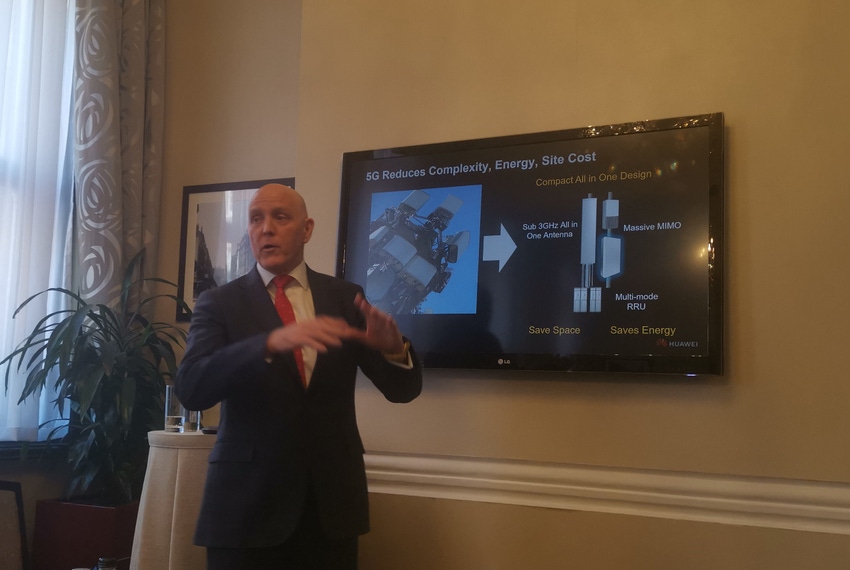Fixed wireless access (FWA) should not be considered an alternative for fibre connectivity in the home, but that does not mean it should be ignored as a usecase to justify expenditure.
April 1, 2019

Fixed wireless access (FWA) should not be considered an alternative for fibre connectivity in the home, but that does not mean it should be ignored as a usecase to justify expenditure.
“5G is not about speed but about making money,” said Paul Scanlan, CTO for the Huawei Carrier Business Group.
Those who are basing business models around the idea that 5G will deliver faster connectivity are heading down a perilous road. There will be an opportunity to make money from faster connections, but a 5G-orientated telco thinks about the economics of connectivity differently, according to Scanlan. One example is the FWA buzz.
In some circles, FWA is being touted as an alternative to fibre broadband. For Scanlan, this is short-sighted, but it can create a more attractive position to ease the transition from legacy networks through to the future proof infrastructure.
Two concepts of fibre connectivity are completely unavoidable; firstly, its expensive to deploy a fibre network, and secondly, its very time-consuming. The materials are in high-demand pushing up the price, digs are laborious and planning permission laws can create a complicated red-tape maze. These are some of the reasons mobile connectivity vastly outstrips fibre deployments, which generally only grow 5% a year.
In certain geographies, the FWA usecase is an incredibly valuable one. Not only is it quicker to deploy, offering fibre-like speeds sooner rather than later, it is cheaper. Telcos can start delivering fibre-like broadband services immediately, increasing customer satisfaction, while these revenues can offset the heavy financial demands of deploying fibre. It’s a slightly different mindset, but FWA could aid the inevitable.
This is where the ‘bigger, faster, meaner’ mentality of the telcos could create a risk. It is simply not sustainable. Connectivity is becoming increasingly expensive, and consumers are paying less. This is not an attractive equation, but new services can eliminate the chasm.
Latency and transmission are two areas which are not attracting as much attention but could be the difference between the digital service provider of tomorrow and a utilitised telco for connectivity. With 5G, Huawei is promising latency can be reduced by 30-50X, while throughput can be increased by 16X; these numbers can create a more attractive business model.
On the latency front, there are some telcos across Asia who are attempting to monetize latency, creating added value services for gamers. For $1 a month, gamers can turn-on ‘low latency mode’ which can be the difference between winning and losing for certain titles. At $1 a month, it isn’t going to turn the tides, but enough of these value-adds fights back against the pressure of utilitisation trends.
Another interesting usecase is in the smart factory, using latency to remove intelligence off the robots. Scanlan highlighted very few people would buy a $1 million robot, but demand would be much higher for the same device priced at $1,000. The difference between the two could be removing the intelligent component from the robot and hosting them in the cloud. But for this to be a reality, latency would have to be significantly reduced. This is another monetization opportunity for the telcos.
Looking at transmission, Scanlan points to consumer traffic growth. If growth continues its current trajectory, at least 25% year-on-year, 4G will hit a glass ceiling within three years. 4G would have to increase network densification by 160% to meet the demands, though 5G could be the answer. Yes, there will need to be more small cell sites to address the coverage requirements, but each of these sites will have dramatically increased capabilities to deal with the traffic consumption.
Huawei claims CAPEX expenditure would have to increase by 5X for 4G to meet the demands if traffic increased by 50%, though it would only be 1.8X for 5G infrastructure. This creates a much more palatable equation for a scenario which is inevitable.
“What is the real reason for big 5G, it is significantly more efficient,” said Scanlan.
5G is faster, there is no avoiding this fact, but building a business around such a narrow focus is incredibly dangerous. The days of the ‘bigger, meaner, faster’ mentality is quickly dying in the telco world.
About the Author(s)
You May Also Like








.png?width=300&auto=webp&quality=80&disable=upscale)


_1.jpg?width=300&auto=webp&quality=80&disable=upscale)


.png?width=800&auto=webp&quality=80&disable=upscale)